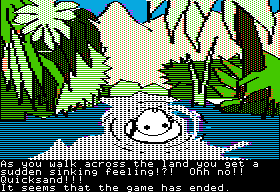We're reaching the end of the Famicom's prehistoric era. 1985 would be the last of those primitive years when its games felt like extensions (when they weren't conversions) of early 80's arcade hits, taking little advantage of the system's scrolling abilities and being constrained by the 40KB limits of its own cartridges. The stateside release of the NES, introducing Super Mario Bros., changed everything, and these back catalog games would be introduced to the U.S. as budget titles.
January (some sources say late 1984) saw the original Japaneses release of two such games - Balloon Fight and Ice Climber. As with many Nintendo games from this era, both were available in the U.S. as part of Nintendo's "VS." arcade machines series, but I believe the NES/Famicom versions are the original design.
Game 391: Balloon Fight
I first played this with my wife, who beat me on the first round, but we hadn't recorded video. I replayed with "B" along with Ice Climber.
Balloon Fight is pretty much a Joust clone to the point where I find I don't have a whole lot to say about it. Instead of riding an ostrich and jousting other knights off theirs, you have a pair of balloons and fly around an arena by flapping your arms, and try to fight a flock of bird people by popping their balloons with your feet while trying to prevent them from doing the same to you. It's slower, floatier, and more forgiving than Joust, and if anything, the concept is less outlandish.
Designer Satoru Okada must have taken pity on your fingers, though, because unlike Joust, Balloon Fight lets you auto-flap by holding the 'B' button. It's a welcome addition over the tiring manual button bashing in Joust.
Nintendo's early games often had extra modes, and Balloon Fight features one called "Balloon Trip" where you fly in a neverending journey to the west over an endless sea, dodging screenfulls of lighting bolts and popping stray balloons for bonus points. It's solo-only, but kind of fun, and I dig the catchy, playful music by sound engineer Hirokazu Tanaka.
GAB rating: Above average. This is one of the better early Famcom titles, but I'd rather just play Joust again than play this. Balloon Trip is alright, but the main event takes too long before it gets challenging.
Game 392: Ice Climber
January's other notable Nintendo game takes its cues mainly from the original Mario Bros. (which itself owed much to Joust), but it isn't just an arctic-themed clone.
Back in the NES days, Ice Climber was barely a blip on my radar. I must have seen some screenshots in books, but I never played it, and never gave it any thought until its protagonists Popo and Nana returned as playable characters in 2001's Super Smash Bros. Melee.
If you watch the video - this is our first and only attempt at the game - you can probably feel our frustration vicariously. Mario Bros. already had pretty slippery controls, but Ice Climber's are twice as awkward, especially with its high-arced jumping trajectories that barely clear any kind of horizontal distance whatsoever, making the main task of ascending a mountain of icy platforms a real annoying challenge.
Time after time, our jumps would miss platforms that seemed close enough, causing our hapless nutaqqak to fall, sometimes to their chilly deaths. But you can't just jump from the very edge of each platform either - there's a good chance of hitting your head on the invisible edge of the platform you're aiming to land on, or just sliding off.
Moving cloud platforms on the later stages add even more "fun," requiring precise timing to land on them (they are solid from below, unlike in Mario games where you can simply jump onto them from directly underneath), and even more precise timing to jump from them and onto an ascending platform, and if you miss and live, you've got to wait for what feels like ages for the cloud to wrap around the screen and come around to your position again.
I particularly loved the parts where I had to jump off a cloud to smash ice blocks above me, fall down and repeat until the hole above was wide enough to jump through. While yetis spawn and repair said hole. And if you take too long, a polar bear in sunglasses and a Speedo comes by and forces the screen to scroll upward, likely killing you. And when you respawn, the game just loves placing you right in the path of an unavoidable yeti who kills you again. Yay!
Fun bit of trivia - in an early example of regional censorship, the original Japanese version features baby seals as enemies.
 |
| Somebody call the IFAW. |
GAB rating: Below average. "B" thought that Ice Climber might be more fun if we took the time to overcome the learning curve of its weird jumping mechanics and platform collision detection, but I feel less charitable. First impressions count a lot for arcade-styled games. It wasn't fun for either of us, and even in the 15 minutes we played, seemed awfully shallow and repetitive. Another fossil best left frozen in Nintendo's crevices.



































































